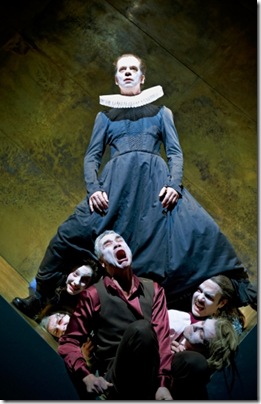Tartuffe: Evil incarnate unleashes a chilling message to the world.
Photo: Courtesy of the Schaubuhne Berlin.
One of the most hated creations of the Classical French stage is the impostor Tartuffe, the false confessor, the spiritual guide, presented to us by the image of a gesticulating fanatic in a long black swirling dress and huge white collar, evoking Mme Pernelle, a Jansenist priest and a roaring Goebbels-like creature haranguing the audience about the qualities of this saintly man but using the vocal tones and gestures of a creature leading a Hitler rally . Exploding on Olaf Altman’s set like a fiery fanatic in bristling punky hair, this creature sets up the past life of Tartuffe and prepares us for the seduction and Christian martyr scenario that follows. Tartuffe arrives, dragging himself into the world like a tortured soul, seeking the most horrible vengeance , spouting hate and destruction from all his orifices. The die is cast, and the worst is yet to come. In this version, all is played out in waves of highly charged physicality. Director Michael Thalheimer , by transforming the family confessor into a sincere fanatic who never tries to disguise his tendencies, has created a creature that is more cruel, more relentless and certainly more dangerous than he ever was in the traditional version of the play. True power is played out within rituals that highlight sexuality, as Jean Genet has always shown us and this German production emphasizes that fact. The urgency of this political message is very clear. Molière has finally entered into the 21st Century, much to the delight of the younger members of the audience.
Thalheimer’s adaptation respects the original structure of the play, except for one important difference. He removes the final pages where the King’s representative, the Exempt, arrives to arrest Tartuffe and restore all of Orgon’s property that the head of the household has given him. In the French version, this was a political deus ex machina moment that Moliere included to honour the king but in fact it has nothing to do with anything in the play as Thalheimer so rightly realized. In fact, Molière’s rage against this individual who manipulates and ruins a family is shown with even greater clarity in the German version. Thus Tartuffe gets away free, and the evil he incarnates has been unleashed upon the world, free to destroy again. The play’s dynamics are reversed and the message is all the more chilling.
Also interesting in this production was the introduction of a great variety of performance styles, such as the sinister liturgical drama that brought us back to an exacerbated version of the atmosphere of M.G. Lewis’ gothic novel The Monk played out in the first few minutes of the evening when the characters quote the bible and chant their dialogue, imitating the exchange between the confessor and condemned sinner. Tartuffe is drawn as the new deity of evil while Orgon, the husband who has invited him into his household is the prophet, announcing the coming of that miserable creature. The organ music, the religious vibrations of frightening sounds are perfect additions to this scene. Later the tone becomes more lighthearted as each of the characters assumes a comic performance to highlight how the rest of the family is transformed into creatures that were constantly playing heightened roles, pretending to be what they were not, assuming artificial postures of pretense that distinguished them from the honest saintly fanatic, the only character in the whole group who was not pretending. They bubbled and jerked, and went overboard in the most extraordinary corporeal exhibitions of pure comic absurdity. Orgon turns into Louis de Funes as soon as he realizes what his hero is up to with this wife. Valère becomes an actor out of a Monty Python skit with his long gangly , awkward stretched out legs while Marianne jerks and trembles and seems to be undergoing terrible spasms as though she had Tourette ’s syndrome as we get glimpses of a Marat Sade scenario within this household quickly becoming a space of madness. Damis the son, stands there nibbling away at a cracker like a mouse, as though he had escaped from the turning set, an in depth picture frame wired to whirl around like one of those little guinea pig cages where the mechanism turns frantically, tossing the members of the family about until they lose all perspective, and end up in a heap white faced and exhausted. The ultimate detail: their wigs fall off, leaving them zombie like, unmasked, morally and physically ruined. And Tartuffe walks away perfectly in control.
Elvire remains distant and Dorine, the servant who always maintains her stance of independence in Moliere’s world is the only character who is not partially seduced by this phenomenon and she returns to her religious roots to plead for help because she understands what Tartuffe is up to. Unfortunately, it is too late. In this scenario where politics and religion become the most oppressive forces on earth, Michael Thalheimer has created a monster that the original author could never have suspected, a monster that sets this play squarely in the twenty first century where conflicts of this nature are raging around the world. Never has a play by Molière received such a contemporary reading.
Tartuffe by Molière,
Presented at the Festival TransAmérique, 22 – 24 May, 2015
A production of the Schaubühne Berlin
Directed and adapted by Michael Thalheimer, originally translated into German by Wolfgang Wiens
Musique Bert Wrede
Set Olaf Altmann
Costumes Nehle Balkhausen
Cast:
Tartuffe Lars Eidinger
Orgon Ingo Hülsmann Orgon
Cléante Kay Bartholomäus Schulze
Marianne Luise Wolfram etc.
